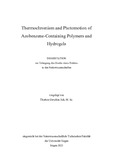Citation link:
http://dx.doi.org/10.25819/ubsi/10267Files in This Item:
| File | Description | Size | Format | |
|---|---|---|---|---|
| Dissertation_Jaik_Thorben.pdf | 43.25 MB | Adobe PDF |  View/Open |
| Dokument Type: | Doctoral Thesis | metadata.dc.title: | Thermochromism and photomotion of azobenzene-containing polymers and hydrogels | Other Titles: | Thermochromie und Fotobewegung von azobenzolhaltigen Polymeren und Hydrogelen | Authors: | Jaik, Thorben Gwydion | Institute: | Department Chemie - Biologie | Free keywords: | Thermochromism, Polymers, Azobenzene, Photomotion | Dewey Decimal Classification: | 540 Chemie | GHBS-Clases: | UXGF UUJ UZS |
Issue Date: | 2022 | Publish Date: | 2023 | Abstract: | Diese Arbeit befasst sich mit der Synthese, der Thermochromie und der Photoaktuation von azobenzolhaltigen Polymeren und Hydrogelen. Zur Herstellung dieser Polymere wurden Monomere auf Basis des Azofarbstoffs Methylrot synthetisiert, in denen die Chromophore über unterschiedliche funktionelle Gruppen mit polymerisierbaren Gruppen verbunden wurden. Diese Monomere zeigten abhängig von Protonierung und Lösungsmittel eigenes thermochromes Verhalten. Durch Aufklärung der Thermochromie der freien Farbstoffe konnte diejenige der Copolymere erklärt werden. Der Ausgangsfarbstoff Methylrot wurde mit einem Alkohol oder mit primären und sekundären Aminen funktionalisiert, um Ester, oder sekundäre und tertiäre Amide direkt am aromatischen Ring zu erhalten. Diese zeigten stark unterschiedliche thermochrome Effekte. Für den Ester konnten Thermohalochromie, Thermosolvatochromie und Thermosolvatohalochromie gezeigt werden, was die Aufklärung von thermochromem Verhalten in nicht-thermoresponsiven und thermoresponsiven Copolymeren und Hydrogelen mit unterer kritischer Lösungstemperatur ermöglichte. Die Hydrogele konnten durch Fotovernetzung hergestellt werden. Sowohl Polymere in Lösung als auch Gele beeinflussen Thermohalochromie des Farbstoffs stark. Sekundäre Amide an beiden Seiten einer Alkylkette zwischen Chromophor und polymerisierbarer Gruppe führten zu komplexen Effekten in Thermohalochromie, da Wasserstoffbrückenbindungen das einfache Gleichgewicht zwischen neutraler und protonierter Form verändern. Ein tertiäres Amid in ortho-Position zur Azobrücke führte zu einer ausgeprägten Verlagerung des Gleichgewichts zwischen Ammonium- und Azoniumion des protonierten Azofarbstoffs verglichen mit anderen Pseudostilbenen. Es trat Thermotautochromie auf und durch intramolekulare Wasserstoffbrücken wurde saure Hydrolyse des tertiären Amids schon bei niedrigen Temperaturen beobachtet. Die Struktur und Fähigkeit zur Wasserstoffbrückenbildung der zugehörigen Copolymere und Gele bestimmten die Temperatur, zu der Hydrolyse dominant wurde. Wenn die Azohydrogele mit einem Laser bestrahlt wurden, statt einer Temperaturänderung ausgesetzt zu werden, konnte intensive Photobewegung beobachtet werden. In thermoresponsiven Hydrogelen wurde ein schneller Kollaps auf großer Fläche beobachtet, der lokalen photothermalen Effekten zugeschrieben wurde. Durch Austausch des Mediums zu Isopropanol wurde die Thermoresponsivität unterdrückt und eine sehr viel kleinere, aber schnellere Bewegung beobachtet. Dieses Verhalten trat auch bei nicht-thermoresponsiven Hydrogelen auf. Auf diese Weise konnten zwei verschiedene Modi der Photoaktuation durch Wahl der Polymermatrix gezeigt werden. This work describes the synthesis, and thermochromic and photoactuation properties of azobenzene-containing polymers and hydrogels. For these polymers, monomers based on the azo dye methyl red were synthesised with varying linkages between the chromophore and the polymerizable group. These monomers showed distinct thermochromic behaviour in solution in dependence on protonation state and solvent. By determining the thermochromism of the single dyes, it was possible to elucidate the thermochromic effects of the corresponding copolymers. The parent dye methyl red was functionalised with either an alcohol, a primary amine, or a secondary amine, yielding an ester, secondary amide, or tertiary amide attached to the aromatic ring, respectively. These exhibited largely varying thermochromic behaviours. It was possible to identify thermo-halochromism, thermo-solvatochromism, and thermo-solvatohalochromism for the ester, which provided the foundation to understand thermochromic effects and their interplay in non-thermoresponsive and lower critical solution temperature type thermoresponsive copolymers and hydrogels, which could be obtained through photocrosslinking. Both polymers in solution and gels strongly influence thermo-halochromism of this azo dye. Secondary amide functionalities on two ends of a tether between chromophore and polymerizable unit lead to intricate effects on thermo-halochromism, disturbing the simple equilibrium between neutral and protonated form by hydrogen bonding motifs in dependence on the tether length. A tertiary amide in ortho-position to the azo bridge results in a distinct shift in the tautomeric equilibrium between ammonium and azonium form of the protonated azo dye compared to other pseudostilbenes. Thermo-tautochromism occurs and acidic hydrolysis of the tertiary amide is catalysed through intramolecular hydrogen bonding at low temperatures, accompanied by an intense change of colour. The structure and hydrogen bonding capabilities of the corresponding copolymer or gel dictate the temperature at which hydrolysis becomes dominant. When the azo dye-containing hydrogels were exposed to laser light instead of temperature as a trigger, intense photomotion could be observed. In thermoresponsive hydrogels with a cloud point close to room temperature, fast collapse occurred over a large area, which can be attributed to local photothermal effects. By changing the liquid medium to isopropanol instead of water, the thermoresponse can be switched off and the photomotion changed in scale to smaller but faster actuation. The same behaviour is inherent to non-thermoresponsive hydrogels. In this way, two different modes of photoactuation can be exploited by choice of the polymer matrix. |
DOI: | http://dx.doi.org/10.25819/ubsi/10267 | URN: | urn:nbn:de:hbz:467-24600 | URI: | https://dspace.ub.uni-siegen.de/handle/ubsi/2460 |
| Appears in Collections: | Hochschulschriften |
This item is protected by original copyright |
Page view(s)
184
checked on Nov 25, 2024
Download(s)
65
checked on Nov 25, 2024
Google ScholarTM
Check
Altmetric
Items in DSpace are protected by copyright, with all rights reserved, unless otherwise indicated.

